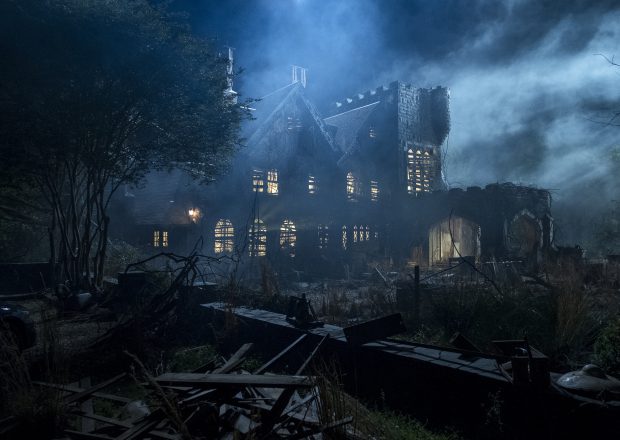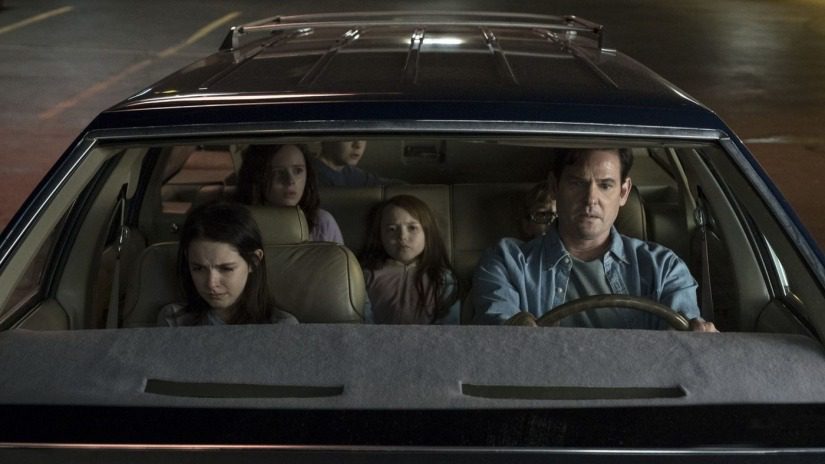Director Mke Flanagan is on the kind of roll not seen since Francis Ford Coppola in the 1970s, or the Coen brothers in the mid-00s. In the past seven years, Flanagan has not made a bad film. He’s responsible for Absentia, Before I Wake, Oculus, Oujia: Origin of Evil, Hush, and Gerald’s Game. The last two of those are flat-out masterpieces; Netflix’s new The Haunting of Hill House could very well be his magnum opus. He’s been given free reign over one of the defining Gothic novels of the twentieth century, and has taken Shirley Jackson’s brilliant, frightening, sad book, and turned it into a meditation on grief and trauma. It’s also scary as hell.
Flanagan approaches Hill House with assured, stately direction, letting the horrifying edifice of the house speak for itself. He frames the titular house with a mixture of awe and terror, and inside he uses long shots to keep us looking in the corners and crevices of the house. Faces abound: busts, statues, even some slyly inserted ghostly visages in the backgrounds of scenes. We’re never alone here. Not even watching at home.
Gothic horror is built on the slow burn, and Flanagan has turned it into an art form (you can see this too in Gerald’s Game, which goes so gradually from tension to white-knuckle horror that you hardly even notice until you’re terrified). We meet the Crain family after they’ve moved into Hill House, so Hugh Crain (Henry Thomas, fantastic) can flip it for a profit. One of Flanagan’s smartest tactics is to skip the moving-in phase that seems to be a prerequisite in horror films – the Crain family lives here, has lived here, and the seemingly sentient house doesn’t seem to want them there. Nell, the youngest daughter, has nightmares of a “bent-neck lady”; later, we see Nell’s face as she sees the lady, and it’s here that we realize just looking at someone in the grip of absolute terror is just as horrific as seeing whatever is scaring them.
The biggest change Flanagan makes to Jackson’s novel is in the family dynamic. Here, Nell (the main character of the book) has four siblings: Theo, Shirley, Steven, and Luke. Some of these were other characters in Jackson’s book (except for Shirley, obviously named for the author herself), but by combining these characters, disparate in the book, into one cohesive whole, Flanagan (who also wrote the teleplay) can focus on the meat of Hill House‘s story, which is that of the family Crain. Like Hereditary, The Haunting of Hill House is about the sometimes corrosive effect of family; it’s about grief, and inherited trauma, and the horror of trying to escape either of those. Throughout “Steven Sees a Ghost,” we see several scarring events in the childrens’ lives, from Nell’s encounter with the bent-neck lady, to a scene of almost unparalleled intensity, as Hugh comes into Steven’s room, imploring him to be quiet, and saying they have to leave at that moment. “We’re gonna run,” Hugh tells his son, and in Henry Thomas’ performance, you can see the desperation of a parent allowing their child to see them scared witless. As the family peels away from Hill House, a woman is seen standing in a window. “That’s not mom,” Hugh tells his children. We later find out she committed suicide.
The ghosts of the past become literal in Flanagan’s series (which, according to interviews, he approached as though he were making a ten-hour movie). Shirley (Elisabeth Reaser) works at a funeral home, where Theo (played by Kate Siegel of Hush) also lives. Steven (Michiel Huisman) is an author of paranormal investigative books, the most famous of which is The Haunting of Hill House. No one in the family has ever truly let go of, or even reckoned with, their past. Flanagan cuts seamlessly between past and present (subtitled “Then” and “Now”), suggesting that the two are not separate, but perhaps layers of the same.
The question you might be asking now is: is the show scary? Of course it is. Jackson’s source material notwithstanding (and it remains one of the scariest books I’ve ever read), Flanagan is unusually adept at mounting tension until it reaches its breaking point. There are no jump scares in Flanagan’s films; he trusts his audience’s patience, and rewards it. At one point, a drop of water falls on Steven’s forehead, and I almost jumped out of my seat. When Steven lives up to the title and sees a ghost, the scene takes on the timbre of an urban legend, as his father tells him that his sister Nell has died in the old house – but Nell is right there, standing in Steven’s apartment. Expanding Jackson’s book to reach beyond the confines of the house was a masterstroke on Flanagan’s part, and it’s exciting to see a filmmaker of this caliber and pedigree given the freedom to paint with Jackson’s brushes. In a nice nod to the book, Steven reads the first paragraph aloud; to this day, it remains one of the purest examples of Gothic writing in history. This is, maybe, the most truly frightening show on TV right now. American Horror Story can’t match it for scares, and neither can Black Mirror or Channel Zero. One episode in, and Flanagan’s series is proving to be as essential as Jackson’s novel.
A Few Thoughts
- That was Saidah Arrika Ekulona as Irene Walker, giving one of the most terrifying monologues I’ve ever seen. Her performance was made of all the stuff of horror: fear, sadness, loneliness. So much of what makes The Haunting of Hill House effective is what we don’t see, and Ekulona’s Emmy-worthy monologue is indicative of that ethos.
- “A ghost can be a lot of things. A memory, a day dream, a secret; grief, anger, guilt.”
- Nice touch that the master key doesn’t open the attic room. The house is alive, and it has its secrets.
4.5/5



